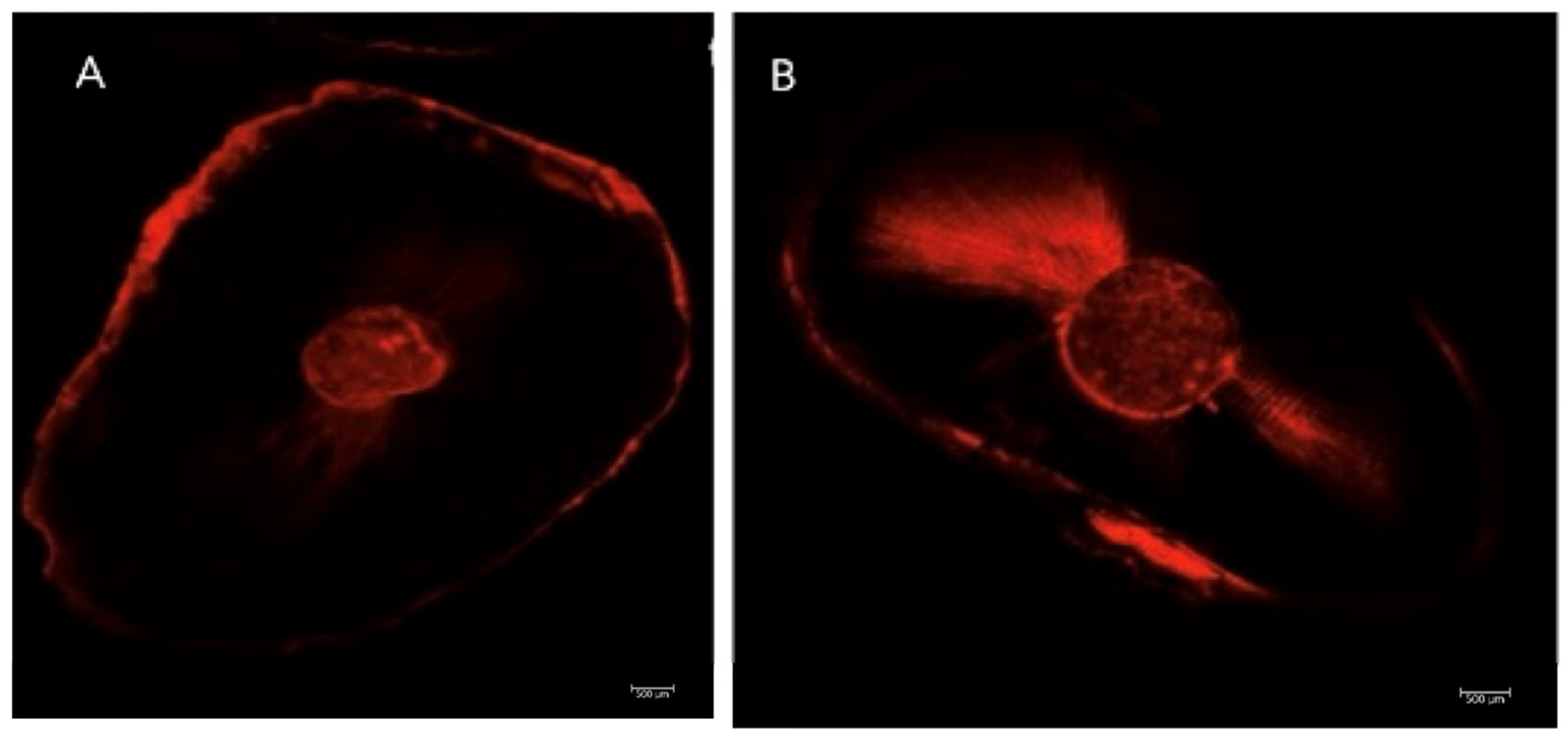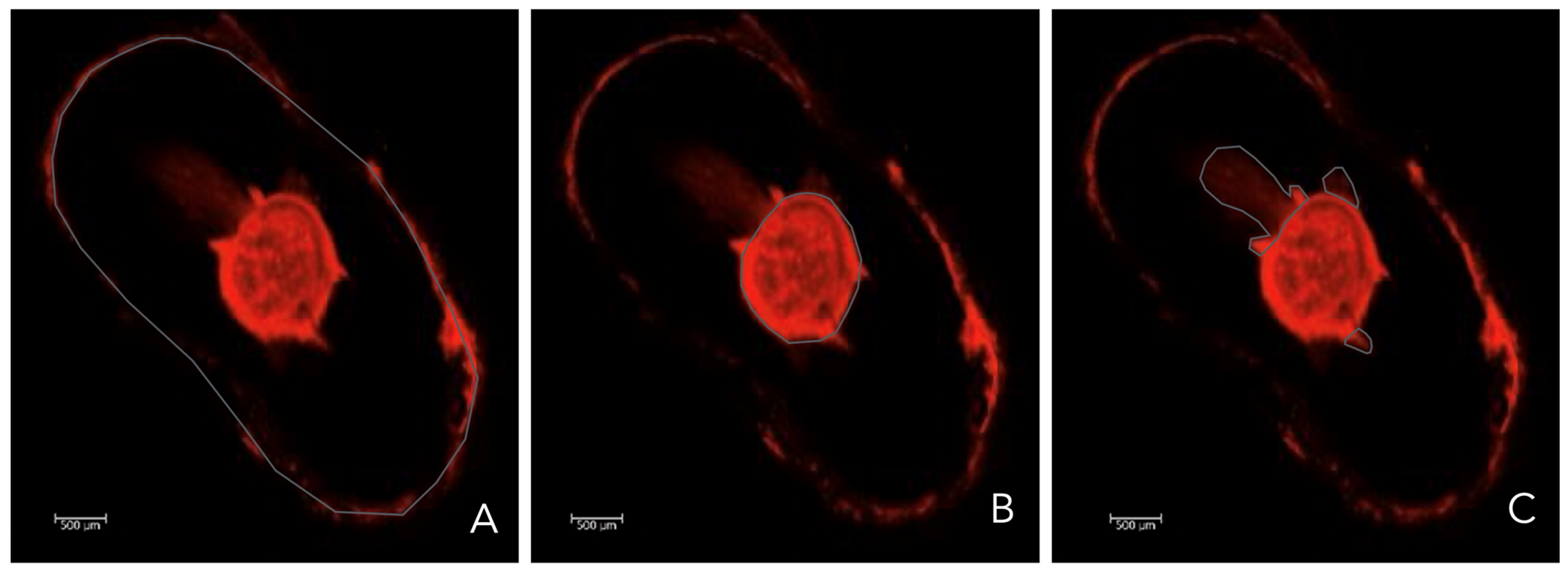Comparative Evaluation of the Intratubular Penetration Ability of Two Retrograde Obturation Techniques in Micro-Endodontic Surgical Procedure: An In Vitro Study with Confocal Laser Scanning Microscopy
Abstract
1. Introduction
2. Materials and Methods
2.1. Sample Selection
2.2. Preparation of the Root Canal
2.3. Obturation of Root Canals
2.4. Apicoectomy of the Samples
2.5. Retrocavity
2.6. Retrograde Obturation of the Samples
2.7. Study Groups
2.8. Sample Cutting
2.9. Imagen Analysis: Confocal Laser Scanning Microscopy (CLSM)
2.10. Statistical Analysis
3. Results
Study or the Percentage Intratubular Penetration Area for the Bioceramic Cements in the Dentinal Tubules
4. Discussion
5. Conclusions
Author Contributions
Funding
Institutional Review Board Statement
Informed Consent Statement
Data Availability Statement
Conflicts of Interest
References
- Liu, H.; Lai, W.W.M.; Hieawy, A.; Gao, Y.; Haapasalo, M.; Tay, F.R.; Shen, Y. Efficacy of XP-endo instruments in removing 54 month-aged root canal filling material from mandibular molars. J. Dent. 2021, 112, 103734. [Google Scholar] [CrossRef]
- Nasseh, A.A.; Brave, D. Apicoectomy: The Misunderstood Surgical Procedure. Dent. Today 2015, 34, 130, 132, 134–136. [Google Scholar]
- Lee, S.M.; Yu, Y.H.; Wang, Y.; Kim, E.; Kim, S. The Application of “Bone Window” Technique in Endodontic Microsurgery. J. Endod. 2020, 46, 872–880. [Google Scholar] [CrossRef]
- Jadun, S.; Monaghan, L.; Darcey, J. Endodontic microsurgery. Part two: Armamentarium and technique. Br. Dent. J. 2019, 227, 101–111. [Google Scholar] [CrossRef]
- Monaghan, L.; Jadun, S.; Darcey, J. Endodontic microsurgery. Part one: Diagnosis, patient selection and prognoses. Br. Dent. J. 2019, 226, 940–948. [Google Scholar] [CrossRef] [PubMed]
- Dong, X.; Xu, X. Bioceramics in Endodontics: Updates and Future Perspectives. Bioengineering 2023, 10, 354. [Google Scholar] [CrossRef] [PubMed]
- Raghavendra, S.S.; Jadhav, G.R.; Gathani, K.M.; Kotadia, P. Bioceramics in endodontics—A review. J. Istanb. Univ. Fac. Dent. 2017, 51 (Suppl. S1), S128–S137. [Google Scholar] [CrossRef] [PubMed]
- Donnermeyer, D.; Schemkämper, P.; Bürklein, S.; Schäfer, E. Short and Long-Term Solubility, Alkalizing Effect, and Thermal Persistence of Premixed Calcium Silicate-Based Sealers: AH Plus Bioceramic Sealer vs. Total Fill BC Sealer. Materials 2022, 15, 7320. [Google Scholar] [CrossRef]
- Iftikhar, S.; Jahanzeb, N.; Saleem, M.; Ur Rehman, S.; Matinlinna, J.P.; Khan, A.S. The trends of dental biomaterials research and future directions: A mapping review. Saudi Dent. J. 2021, 33, 229–238. [Google Scholar] [CrossRef]
- Aminoshariae, A.; Primus, C.; Kulild, J.C. Tricalcium silicate cement sealers: Do the potential benefits of bioactivity justify the drawbacks? J. Am. Dent. Assoc. 2022, 153, 750–760. [Google Scholar] [CrossRef]
- Zafar, K.; Jamal, S.; Ghafoor, R. Bio-active cements-Mineral Trioxide Aggregate based calcium silicate materials: A narrative review. J. Pak. Med. Assoc. 2020, 70, 497–504. [Google Scholar] [CrossRef]
- Abdulsamad Alskaf, M.K.; Achour, H.; Alzoubi, H. The Effect of Bioceramic HiFlow and EndoSequence Bioceramic Sealers on Increasing the Fracture Resistance of Endodontically Treated Teeth: An In Vitro Study. Cureus 2022, 14, e33051. [Google Scholar] [CrossRef]
- Rebolledo, S.; Alcántara-Dufeu, R.; Luengo Machuca, L.; Ferrada, L.; Sánchez-Sanhueza, G.A. Real-time evaluation of the biocompatibility of calcium silicate-based endodontic cements: An in vitro study. Clin. Exp. Dent. Res. 2023, 9, 322–331. [Google Scholar] [CrossRef]
- Al-Hiyasat, A.S.; Alfirjani, S.A. The effect of obturation techniques on the push-out bond strength of a premixed bioceramic root canal sealer. J. Dent. 2019, 89, 103169. [Google Scholar] [CrossRef] [PubMed]
- Casino Alegre, A.; Aranda Verdú, S.; Zarzosa López, J.I.; Plasencia Alcina, E.; Rubio Climent, J.; Pallarés Sabater, A. Intratubular penetration capacity of HiFlow bioceramic sealer used with warm obturation techniques and single cone: A confocal laser scanning microscopic study. Heliyon 2022, 8, e10388. [Google Scholar] [CrossRef]
- Arvelaiz, C.; Fernandes, A.; Graterol, V.; Gomez, K.; Gomez-Sosa, J.F.; Caviedes-Bucheli, J.; Guilarte, C. In Vitro Comparison of MTA and BC RRM-Fast Set Putty as Retrograde Filling Materials. Eur. Endod. J. 2022, 7, 203–209. [Google Scholar] [CrossRef] [PubMed]
- Kato, G.; Gomes, P.S.; Neppelenbroek, K.H.; Rodrigues, C.; Fernandes, M.H.; Grenho, L. Fast-Setting Calcium Silicate-Based Pulp Capping Cements-Integrated Antibacterial, Irritation and Cytocompatibility Assessment. Materials 2023, 16, 450. [Google Scholar] [CrossRef] [PubMed]
- Alghamdi, F.; Alhaddad, A.J.; Abuzinadah, S. Healing of Periapical Lesions After Surgical Endodontic Retreatment: A Systematic Review. Cureus 2020, 12, e6916. [Google Scholar] [CrossRef]
- Koch, K.A.; Brave, D.G. Bioceramics, Part 2: The clinician’s viewpoint. Dent. Today 2012, 31, 118, 120, 122–125. [Google Scholar]
- Queiroz, M.B.; Inada, R.N.H.; Jampani, J.L.A.; Guerreiro-Tanomaru, J.M.; Sasso-Cerri, E.; Tanomaru-Filho, M.; Cerri, P.S. Biocompatibility and bioactive potential of an experimental tricalcium silicate-based cement in comparison with Bio-C repair and MTA Repair HP materials. Int. Endod. J. 2023, 56, 259–277. [Google Scholar] [CrossRef]
- Gülmez, H.K.; Kaya, S.; Özata, M.Y. Comparison of dentinal tubule penetration of three different root canal sealers by confocal laser scanning microscopy. Endodontology 2023, 35, 107–112. [Google Scholar] [CrossRef]
- Kiatpattanakrai, A.; Phumpatarakhom, P.; Dewi, A.; Louwakul, P. Evaluation of Void Volume and Blood Contamination-Induced Changes in Surface Microhardness of Calcium Silicate-Based Cement, Sealer, and Their Combination (Lid Technique) in Retrograde Filling. Eur. Endod. J. 2025, 10, 319–325. [Google Scholar] [CrossRef]
- Hashmi, A.; Zhang, X.; Kishen, A. Impact of Dentin Substrate Modification with Chitosan-Hydroxyapatite Precursor Nanocomplexes on Sealer Penetration and Tensile Strength. J. Endod. 2019, 45, 935–942. [Google Scholar] [CrossRef]
- Awati, A.S.; Dhaded, N.S.; Mokal, S.; Doddwad, P.K. Analysis of the depth of penetration of an epoxy resin-based sealer following a final rinse of irrigants and use of activation systems: An in vitro study. J. Conserv. Dent. Endod. 2024, 27, 87–94. [Google Scholar] [CrossRef]
- Jeong, J.W.; DeGraft-Johnson, A.; Dorn, S.O.; Di Fiore, P.M. Dentinal Tubule Penetration of a Calcium Silicate-based Root Canal Sealer with Different Obturation Methods. J. Endod. 2017, 43, 633–637. [Google Scholar] [CrossRef]
- McMichael, G.E.; Primus, C.M.; Opperman, L.A. Dentinal Tubule Penetration of Tricalcium Silicate Sealers. J. Endod. 2016, 42, 632–636. [Google Scholar] [CrossRef]
- Chao, Y.C.; Chen, P.H.; Su, W.S.; Yeh, H.W.; Su, C.C.; Wu, Y.C.; Chiang, H.S.; Jhou, H.J.; Shieh, Y.S. Effectiveness of different root-end filling materials in modern surgical endodontic treatment: A systematic review and network meta-analysis. J. Dent. Sci. 2022, 17, 1731–1743. [Google Scholar] [CrossRef] [PubMed]
- Damas, B.A.; Wheater, M.A.; Bringas, J.S.; Hoen, M.M. Cytotoxicity comparison of mineral trioxide aggregates and EndoSequence bioceramic root repair materials. J. Endod. 2011, 37, 372–375. [Google Scholar] [CrossRef] [PubMed]
- Lovato, K.F.; Sedgley, C.M. Antibacterial activity of endosequence root repair material and proroot MTA against clinical isolates of Enterococcus faecalis. J. Endod. 2011, 37, 1542–1546. [Google Scholar] [CrossRef] [PubMed]
- Ma, J.; Shen, Y.; Stojicic, S.; Haapasalo, M. Biocompatibility of two novel root repair materials. J. Endod. 2011, 37, 793–798. [Google Scholar] [CrossRef]
- Mozayeni, M.A.; Salem Milani, A.; Alim Marvasti, L.; Mashadi Abbas, F.; Modaresi, S.J. Cytotoxicity of Cold Ceramic Compared with MTA and IRM. Iran. Endod. J. 2009, 4, 106–111. [Google Scholar]
- Atmeh, A.R.; Chong, E.Z.; Richard, G.; Festy, F.; Watson, T.F. Dentin-cement interfacial interaction: Calcium silicates and polyalkenoates. J. Dent. Res. 2012, 91, 454–459. [Google Scholar] [CrossRef] [PubMed]
- Sarkar, N.K.; Caicedo, R.; Ritwik, P.; Moiseyeva, R.; Kawashima, I. Physicochemical basis of the biologic properties of mineral trioxide aggregate. J. Endod. 2005, 31, 97–100. [Google Scholar] [CrossRef]
- Reyes-Carmona, J.F.; Felippe, M.S.; Felippe, W.T. Biomineralization ability and interaction of mineral trioxide aggregate and white portland cement with dentin in a phosphate-containing fluid. J. Endod. 2009, 35, 731–736. [Google Scholar] [CrossRef]
- Han, L.; Okiji, T. Uptake of calcium and silicon released from calcium silicate-based endodontic materials into root canal dentine. Int. Endod. J. 2011, 44, 1081–1087. [Google Scholar] [CrossRef] [PubMed]
- Chen, B.; Haapasalo, M.; Mobuchon, C.; Li, X.; Ma, J.; Shen, Y. Cytotoxicity and the Effect of Temperature on Physical Properties and Chemical Composition of a New Calcium Silicate-based Root Canal Sealer. J. Endod. 2020, 46, 531–538. [Google Scholar] [CrossRef]
- Eren, S.K.; Örs, S.A.; Aksel, H.; Canay, Ş.; Karasan, D. Effect of irrigants on the color stability, solubility, and surface characteristics of calcium-silicate based cements. Restor. Dent. Endod. 2022, 47, e10. [Google Scholar] [CrossRef]
- Donnermeyer, D.; Schmidt, S.; Rohrbach, A.; Berlandi, J.; Bürklein, S.; Schäfer, E. Debunking the Concept of Dentinal Tubule Penetration of Endodontic Sealers: Sealer Staining with Rhodamine B Fluorescent Dye Is an Inadequate Method. Materials 2021, 14, 3211. [Google Scholar] [CrossRef] [PubMed]
- Enkhbileg, N.; Kim, J.W.; Chang, S.W.; Park, S.H.; Cho, K.M.; Lee, Y. A Study on Nanoleakage of Apical Retrograde Filling of Premixed Calcium Silicate-Based Cement Using a Lid Technique. Materials 2024, 17, 2366. [Google Scholar] [CrossRef] [PubMed]





| Groups | N | % | 95% CI | |
|---|---|---|---|---|
| Lower Limit | Upper Limit | |||
| Lid technique | 30 | 38.69 ± 12.01 | 26.68 | 50.71 |
| Conventional technique | 30 | 74.25 ± 23.14 | 51.12 | 97.39 |
Disclaimer/Publisher’s Note: The statements, opinions and data contained in all publications are solely those of the individual author(s) and contributor(s) and not of MDPI and/or the editor(s). MDPI and/or the editor(s) disclaim responsibility for any injury to people or property resulting from any ideas, methods, instructions or products referred to in the content. |
© 2025 by the authors. Licensee MDPI, Basel, Switzerland. This article is an open access article distributed under the terms and conditions of the Creative Commons Attribution (CC BY) license (https://creativecommons.org/licenses/by/4.0/).
Share and Cite
Casino Alegre, A.; Ramírez López, M.; Monterde Hernández, M.; Aranda Verdú, S.; Rubio Climent, J.; Pallarés Sabater, A. Comparative Evaluation of the Intratubular Penetration Ability of Two Retrograde Obturation Techniques in Micro-Endodontic Surgical Procedure: An In Vitro Study with Confocal Laser Scanning Microscopy. Dent. J. 2025, 13, 509. https://doi.org/10.3390/dj13110509
Casino Alegre A, Ramírez López M, Monterde Hernández M, Aranda Verdú S, Rubio Climent J, Pallarés Sabater A. Comparative Evaluation of the Intratubular Penetration Ability of Two Retrograde Obturation Techniques in Micro-Endodontic Surgical Procedure: An In Vitro Study with Confocal Laser Scanning Microscopy. Dentistry Journal. 2025; 13(11):509. https://doi.org/10.3390/dj13110509
Chicago/Turabian StyleCasino Alegre, Alberto, Michell Ramírez López, Manuel Monterde Hernández, Susana Aranda Verdú, Jorge Rubio Climent, and Antonio Pallarés Sabater. 2025. "Comparative Evaluation of the Intratubular Penetration Ability of Two Retrograde Obturation Techniques in Micro-Endodontic Surgical Procedure: An In Vitro Study with Confocal Laser Scanning Microscopy" Dentistry Journal 13, no. 11: 509. https://doi.org/10.3390/dj13110509
APA StyleCasino Alegre, A., Ramírez López, M., Monterde Hernández, M., Aranda Verdú, S., Rubio Climent, J., & Pallarés Sabater, A. (2025). Comparative Evaluation of the Intratubular Penetration Ability of Two Retrograde Obturation Techniques in Micro-Endodontic Surgical Procedure: An In Vitro Study with Confocal Laser Scanning Microscopy. Dentistry Journal, 13(11), 509. https://doi.org/10.3390/dj13110509







